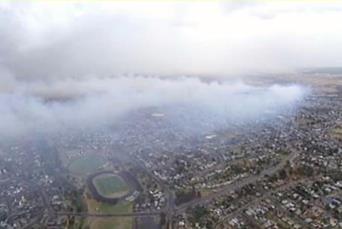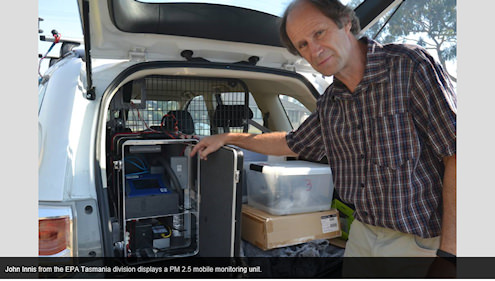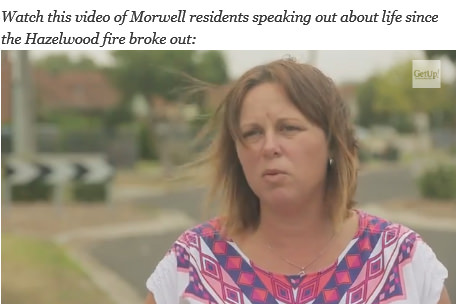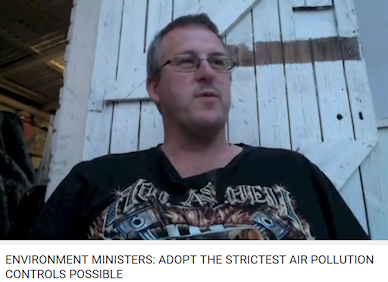7 March 2014 – Low level Hazelwood open cut mine fire smoke advisory – Latrobe Valley – EPA Victoria
See air quality exceedances further down this page.
ABC photo – Aerial of fire burning in Hazelwood open cut mine at Morwell.
Posted Wed 12 Feb 2014, 1:54pm AEDT The fire has been burning underground since the weekend.
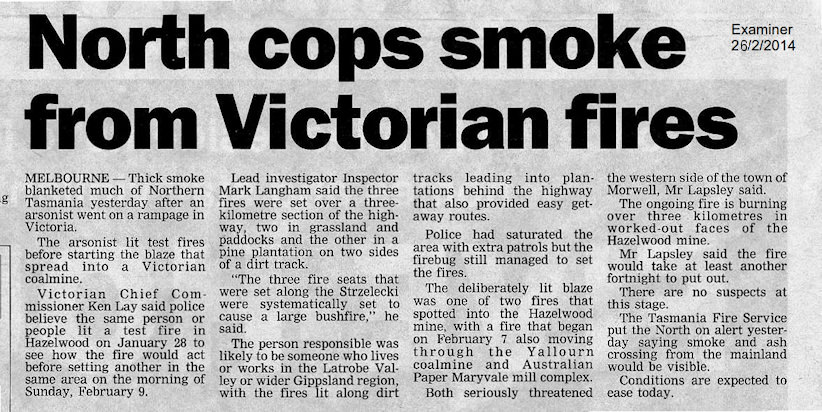
SMOKE ADVICE MESSAGE FOR NORTHERN TASMANIA
Issued At: 25/02/2014 3:21pm
There is a large volume of smoke across Northern Tasmania, particularly between the Tamar River, Fingal Valley and Musselroe Bay.
There is no immediate threat.
Current wind conditions has brought the smoke from fires on mainland Australia.
There may be visible smoke in the area for some time.
People travelling in the area should exercise caution if driving in smoke. Turn on your headlights and drive slowly.
If there is any fire activity causing you concern please report it to the TFS by calling triple zero (000).
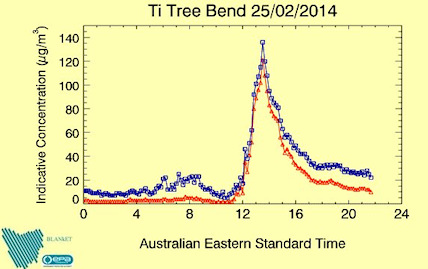
Gippsland and Morwell smoke from Victoria comes into Tasmania
It would seem Victorian authorities were sitting on their laurels for far too long and have been caught napping with the Morwell smoke. This coal fire started on February the 9th. Anyone would think the way this pollution event has been handled it is the first coal mine fire in the region but I am told there have been others (see link above).
Smoke inhalation of this nature and duration will surely shorten lives.
The World Health Organisation has classified (all) outdoor air pollution to be carcinogenic, to cause lung cancer, and has a positive association with bladder cancer.
They have classified Particulate Matter (PM) to be carcinogenic and both these findings were at the highest classification of any cancer group, ie Group1.
Smoke is made up mainly of PM.
The trigger figures the authorities used before evacuation took place was way too high and evacuation should have taken place much, much earlier. The Health department seemed to be stuck on carbon monoxide levels. I believe the public has been misled by Health for not mentioning earlier the harm PM’s can cause.
It is not just about concentration or length of exposure…there is no minimum safe level of exposure.
Fact sheets for: Ash Fallout, Smoke and your Health, Face Masks – Q&A , Rain Water Tanks, Coal Ash and Smoke in the House, Carbon Monoxide, were not uploaded onto the Health website until the 17th – 21st of February. The facts sheets visible now may not be the ones that were placed on these dates and there was a long gap before they were published .
The 24 hour ‘trigger figures’ authorities adhered to corresponded to enormous amounts of particulate matter being inhaled by Morwell residents.
The Precautionary Principle should have been applied.
Smoke of this nature is harmful in minutes and hours, not days and weeks that it took authorities to respond.
It is common sense that if people can smell pernicious smoke then they would have to be breathing it into their lungs.
Go here to read about the harmful effects of particulate matter and Morwell residents were exposed to very high levels of PM.
PM2.5’s travel deep into the lungs and stop there. Gaseous toxins attached to these particles are small enough to carry over into the blood stream and cause all sorts of other (usually not associated to the lay person) health problems. Authorities were actually allowing people’s lungs to filter the air.
From what I have seen people are wearing the wrong types of face masks for this type of pollution.
There can be a latency period of up to 20 years in some people for today’s smoke inhalation problems to show up.
According to Tasmania Fire Service we too were being subjected to Mainland smoke in Northern Tasmania. When wind conditions are right for this to happen particulates have had to travel over 350Km. The lifetime of PM2.5 particle pollution is from days to weeks and their travel distance ranges from 100 to greater than 1000 kilometres.
Toxic levels reached approximately 140gm/m3 on the EPA indicative air monitoring instruments in Launceston this week; a city of about 100,000 people.
No amount of spin by the authorities is going to lessen people’s health problems caused by this smoke. The smoke needs to be stopped at the source and in the meantime people need to be removed from it.
“Particulate pollution is the most important contaminant in our air…We know that when levels go up people die.” – Joel Schwartz., Harvard School of Public Health
The smoke has been described as ‘short term exposure’. Today (28.2.2014) it was described as ‘medium term exposure’. In actual fact it should already be classed as ‘long term exposure’.
It was in my opinion ill-informed for authorities to advise people to stay indoors during a fire of this nature and duration. The reasons can be found here and although in some places it reads ‘woodsmoke’ it is applicable because woodsmoke is made up primarily of PM 2.5 particulates; the same that were being inhaled at Morwell.
Decontamination:
Outdoor particulates would have been sucked into many homes as a result of negative pressure inside the buildings.
Many homes are going to have to be decontaminated before they are fit to live in after the smoke and ash stops. All soft furnishings will have to be hot laundered, walls will have to be scrubbed, hard floors will have to be scrubbed and sterilized. Roof spaces will have to be vacuumed.
Until decontamination, it is not advisable to place infants or let children play on carpeted floors as particulates settle out on them through what is known as the sink effect. The same can happen when a child is put to bed, or on a fabric couch, and these harmful fine particulates are unknowingly breathed in.
Everything has to be cleaned! This is a costly business when done properly by professionals.
Who pays for this?
2/3/2014 – In an email to Dr Rosemary Lester I asked, “…c) Can you also indicate what decontamination program you propose to conduct on properties affected by the smoke/ash from the fire, and when will this be taking place?”
Lisa’s Comment Friday 7 March 2014 6:53 PM at Assistance for Morwell Residents:
“Just to inform people that the Chemist Warehouse – Morwell, 2 Monash Way, are out of stock for the free reliever puffer and a spacer.”
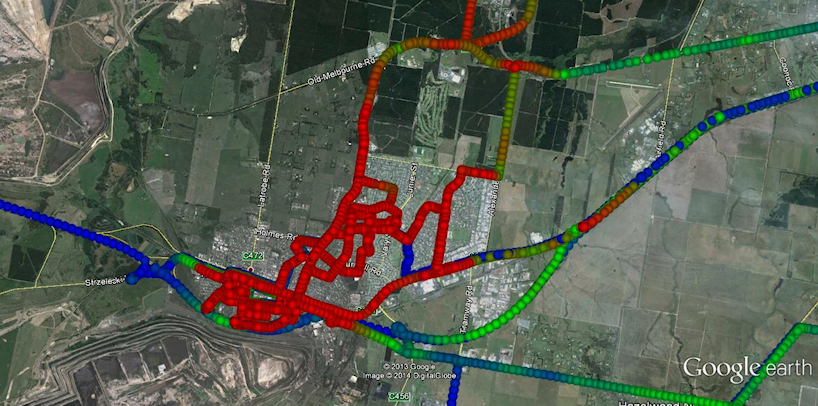
A map that was later released under Right to Information to cleanairtas showing air quality results gathered in and around Morwell on the 23/2/2014 using Travel BLANkET.
Map courtesy of EPA Air Section, Tasmania.
A BUCKET and a bit of PAPER
That sounds like a plan.

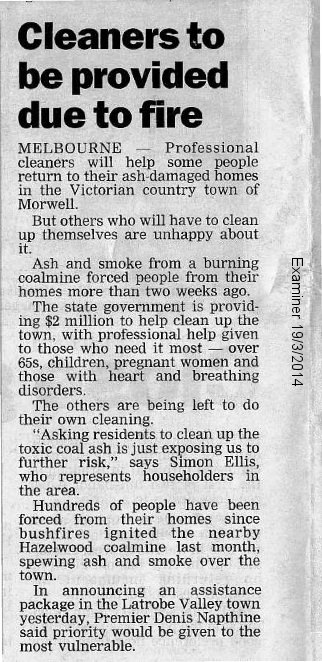
Photo courtesy Latrobe City Council website.
Clean-up. What you need to know.
Decontamination of the fine particulates is a specialised job and should be carried out by professionals; not left to a great many people to do on their own.
Refer to “Decontamination” above…
“Chief Health Officer Rosemary Lester must announce an inquiry into the long-term health impact of the Hazelwood Mine fire on Morwell residents.” say residents.
cleanairtas argues the study should be for 20 years, no less.
Click on the above photo of one resident to access more links on the mine fire and to sign the petition.
And the result?
Public pressure forces 10 year health study. Read about the health study here
cleanairtas points out there can be a latency period of 20 years for health problems to show.
Health Chief agrees study is not long enough. May 8, 2014 Latrobe Valley Express.
20 year health study agreed to.
Hazelwood Inquiry
Air pollution from hazelwood coal mine fire contributed to deaths – 9 December 2015:
RESIDENTS choked by toxic smoke during last year’s Hazelwood coal mine fire have demanded an apology, after a report revealed air pollution from the 45-day fire contributed to an increase in deaths in the Latrobe Valley.
The damning fire inquiry report found the mortality rate in the four months after the fire ignited was 17 per cent higher than the same period in previous years. There was just a one in 12 probability this could have been by chance.
The report also criticised how the Health Department and former Coalition government handled the incident.
http://hazelwoodinquiry.vic.gov.au/hazelwood-mine-fire-inquiry-delivers-volume-ii-of-its-201516-report-to-the-governor-of-victoria/
WARNING: Pollution from coal burning most dangerous for your heart
Hazelwood coal mine operator facing workplace safety charges
It’s official — Australia’s oldest and dirtiest power station will close.
The French owner of Hazelwood, Engie, announced that the 1600 megawatt Hazelwood brown coal power station will close in March 2017.
The Hazelwood mine fire in 2014 has been linked to a spike in doctor visits by Latrobe Valley residents, as well as a jump in rates of prescription medicine being dispensed.
That is according to new findings from the Hazelwood Health Study released today.
The Monash University-led health study, which is being funded by the Victorian Government, found there were an extra 5,137 visits to GPs in the Latrobe Valley in a month when the coal mine fire was alight in 2014 This included 405 cardiovascular visits, 174 respiratory visits and 286 mental health consultations.The increase in GP visits was attributed to the fine particles emitted by the coal fire four years ago.
It was a huge moment in court this month when the jury found Hazelwood Power Partners Pty Ltd Guilty of 10 of the 12 charges brought by Worksafe Victoria for breaches of the Occupational Health and Safety Act 2004.
Earlier this year Hazelwood Power Partners Pty Ltd was found guilty by a jury of all the charges laid against it for breaches of the Environment Protection Act 1970 for causing air pollution.
We won’t know the extent of the penalties that the mine operators will receive until sentencing judgement is handed down, most likely next year.
The four operators of the Hazelwood Power Station have each been fined $95,000 for pollution-related offences resulting from the 2014 mine fire.
May 24, 2020 – Demolition of Hazelwood stacks
Doctors reject AMA chief’s stance on Hazelwood closure and health
While he said the closure of the coal-fired plant was “good news” for children with asthma, the elderly and people who suffered respiratory and cardiovascular illnesses, “there is also the health effects of unemployment that need to be considered”.
Mine fire health study results – so far, see below for latest information
The new: In utero exposure to a severe smoke event was associated with increased parental reports of respiratory infections and wheeze 2–4 years later. In utero exposure had a greater impact on long term respiratory health than early childhood exposure.
The implications: Episodic severe smoke events are common in Australia and elsewhere. Protecting pregnant women and young children should be central to public health responses to poor air quality.
Hazelwood coalmine fire has had lasting health effects on Latrobe valley residents, study finds – The Guardian 29/6/2021
Exposure to hazardous air pollution from the Hazelwood coalmine fire in Victoria has been linked to reduced lung function in people years after the 2014 fire, according to a new study.
Research conducted four years after the mine fire found that adults who had been exposed tofine particulate matter (PM2.5) had decreased respiratory reactance, a measure of the stretchiness of the lungs.
The lung function study forms part of a larger research project into the impacts of the Hazelwood mine fire, including on residents’ psychological and cardiovascular health, not only in Morwell but across the Latrobe valley.
Hazelwood Health Study – Latest information
The fire in the Morwell open cut mine adjacent to the Hazelwood power station blanketed Morwell and the surrounding area in smoke and ash for six weeks in February and March 2014. In response to community concerns about the long-term health effects, the Victorian Department of Health commissioned the Hazelwood Health Study.
IN THE PAST BUT SO MPORTANT
Phone: 1300 442 972
Mail: Hazelwood Mine Fire Inquiry
PO Box 3460
GIPPSLAND MC Vic 3841
Office
20 Hazelwood Road
Morwell VIC 3840
Email:
Go here for all the details.
Closing date for written submissions was the 12th May 2014.

How comforting to know our babies can all go out and breathe heavy smoke.
Morwell people will have something to say about this study in time to come.
Study finds ‘statistically significant association’ between exposure to fine particles in coalmine fire smoke and aging of lungs, equal to 4.7 years.
Further health information:
Smoke is harmful Asthma, COPD, Cancer Tasmania Indoor air quality Australian Medical Students Asn. Submission
CONCLUSION: Combustion of coal, diesel fuel and wood is the likely source of air pollution that affects cancer risk on a large scale, through production of black carbon aerosols with adsorbed polycyclic aromatic hydrocarbons.
Healy Alaska: Coal seam fires burn for years underground
Joint statement on the health effects of coal in Australia
Coal smog. What happened in London
See where the coal mines are in Tasmania – Could similar happen in Tas?

